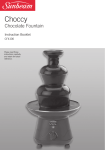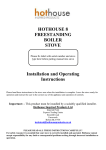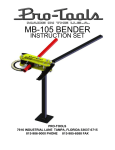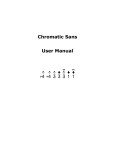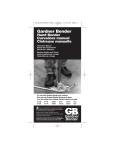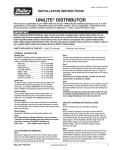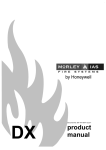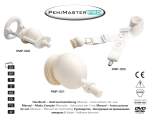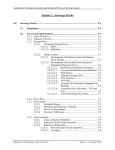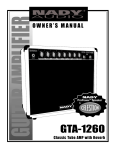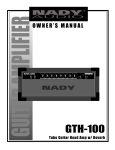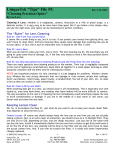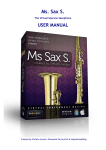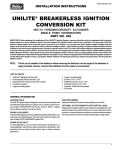Download Fletch Diatonic User`s Manual
Transcript
Fletch Diatonic
A Harmonica Tablature Font
User’s Manual
For an interactive table of contents in Acrobat,
enable bookmarks
(Window, Bookmarks)
© Copyright 2004 Winslow Tully Yerxa
Fletch, Fletch Diatonic, and Discrete Comb are service marks owned by Winslow Yerxa.
Other trademarks mentioned are the property of their respective owners.
About Fletch Diatonic
What it does
Fletch Diatonic is a font for writing harmonica tablature, or tab, for 10-hole and 12hole diatonic harmonicas.
With a single keystroke you can write a tabbed note. This includes the hole number
and the breath direction:
2 3 4 t 5 t 4 3 4 5 6 y 6
If the note is bent down, you can indicate how many semitones:
0 / 9 l k 7
e d c C w s x
Overblows and overdraws may be notated:
4 f r R 5 t T 6 h y Y u 7 (middle octave chromatic scale)
You can also show ways of starting and ending a note with a bend or a rip:
vrb m4 dn 2 bx
You can show various ways of alternating two or more notes with shakes and rakes:
2?6
.y. r.
You can indicate tongue blocked effects such as split intervals:
qzzr 2zz5 3zz6
and slaps, pull-offs, and tremolo lifts:
,3 ,c ,e
Fletch Diatonic
User’s Manual
t, 5, r, ,4 e,,,,,
Page 1 of 16
Capabilities
Fletch Diatonic places the most frequently used characters on the keyboard.
Characters used less frequently are included in the extended character set.
Characters include:
Symbols
Range of Holes
Accessed via
Blow and draw notes
1 – 12
keyboard
All standard bends
Draw 1–6,
Blow 7–12
keyboard
Standard overblows
Blow 1–6
keyboard
Standard overdraws
Draw 7–10
keyboard
Ornaments
n/a
keyboard
blow bends, 1 semitone
1-6
keyboard
Nonstandard draw bends, 1 semitone
7-10
Keyboard
Blow bends lowered 2 semitones
1-10
Extended character set
Blow bends lowered 3 semitones
1-10
Extended character set
Overblows
1-10
Extended character set
Overblows raised 1 semitone
1-10
Extended character set
Overblows raised 2 semitones
1-10
Extended character set
Overblows raised 3 semitones
1-10
Extended character set
Draw bends lowered 2 semitones
1-10
Extended character set
Draw bends lowered 3 semitones
1-10
Extended character set
Overdraws
1-10
Extended character set
Overdraws raised 1 semitone
1-10
Extended character set
Overdraws raised 2 semitones
1-10
Extended character set
Overdraws raised 3 semitones
1-10
Extended character set
Fletch Diatonic
User’s Manual
Page 2 of 16
Getting Started with Fletch Diatonic
Blow notes and draw notes
The most basic information you can tab for harmonica is:
•
What hole you play
•
Whether you blow or draw
The holes of a harmonica are traditionally numbered, starting with Hole 1 at the left.
For each tabbed note, Fletch Diatonic uses a number to indicate which hole is played.
Above the number is an arrow that points up for a blow note, down for a draw note:
5
Up arrow = blow
Hole 5
y
Down arrow = draw
Hole 6
Each tabbed note can be produced by a single keystroke.
The blow note row
The top row of the keyboard is labeled with numbers 1 through 9, and 0. Fletch uses
this row to tab blow notes. The <1> key is for Blow 1, the <2> key is for Blow 2,
and so on. The <0> is Blow 10. The neighboring keys extend to Blow 12:
The draw note row
The second row places the draw notes beneath the blow notes.
Fletch Diatonic
User’s Manual
Page 3 of 16
The diagonal path
Each row of the keyboard is offset to the right from the one above it. This creates a
series of diagonal columns:
A number key — a numbered blow note — is at the head of each diagonal column.
The rest of the column contains additional notes and bends available in the same
hole.
The shifted keys in the same column also contain symbols for that hole:
To get your bearings, always start with the number key for any hole, and follow the
column down diagonally.
Fletch Diatonic
User’s Manual
Page 4 of 16
Beyond blow and draw
Notes on the harmonica may be treated in a variety of ways that go beyond hole
numbers and breathing in and out. New pitches may be created by lowering the pitch
of a note, or bending. Notes may be combined into chords, and they may be
approached, combined, and alternated using physical actions that are characteristic
to the harmonica. Fletch Diatonic includes symbols for these.
Bent notes
Fletch Diatonic indicates bends with slashes, one slash for each semitone. Slashes for
notes that are bent down in pitch incline downward from left to right and are placed
across the arrow shaft:
/
Blow,
bent down 2 semitones
Hole 10
f
Draw,
bent down 1 semitone
Hole 4
The standard diatonic harmonica has a limited number of bent notes available. These
are all represented on the keyboard.
One-semitone bends
One-semitone bends in holes Draw 1–6 and Blow 7–10 appear on the third row of
the keyboard, below the draw notes. To find the bend for any hole number, follow
the diagonal path from the number row down two rows.
Two-semitone bends
Two-semitone bends occur only in Draw 2, Draw 3, and Blow 10. These occur on the
fourth row, below the one-semitone bends:
Three-semitone bend
The only three-semitone bend is in Draw 3. To access it, hold down the <shift> key
and press the key for a two-semitone bend.
Fletch Diatonic
User’s Manual
Page 5 of 16
Holes 11 and 12
The 12-hole diatonic harmonica is seldom used, but it offers some spectacular
bending possibilities — Blow 11 and 12 each bend four semitones.
Fitting these on the keyboard is a challenge. You can see that Hole 11 follows the
diagonal path, while Hole 12 is forced to veer off to the right
Shifting the keys allows for two and three semitones bends:
Four-semitone bends are placed in then upper left corner of the keyboard, to the left
of the <1> key. For Hole 11, use the key unshifted. For Hole 12, hold down the
<shift> key.
Supplemental bent notes
Blow 1–6 or in Draw 7–10 do not bend on a standard diatonic harmonica. However,
they do bend on various other 10-hole harmonicas such as the Discrete Comb,
Suzuki Overdrive, Suzuki Valved Promaster, and Hohner XB-40, as well as on various
alternate tunings.
If you hold down the <shift> key, the one-semitone bends in Row 3 will reverse
breath direction. Draw 1 bend becomes Blow 1 bend, and so on.
Fletch Diatonic
User’s Manual
Page 6 of 16
Overblows and overdraws
A standard unvalved 10-hole diatonic harmonica produces 10 overbends, with
overblows in Holes 1–6 and overdraws in Holes 7–10. The symbol for an overbend is
a small circle through the arrow shaft:
R
Overblow
U
Hole 4
Overdraw
Hole 7
Standard overblows and overdraws are indicated by holding down the <shift key>
and using the second row.
Again, the hole number follows the diagonal path down from the number row.
Extended bends and overbends
Beyond the limits of the standard diatonic, there are many bends and overbends
made available by modifying standard instruments with alternate tunings and the
addition of valves. There are also several new models that offer extended bending
capabilities, such as the Discrete Comb, Overdrive, and XB-40.
Fletch Diatonic offers symbols for these bends through the extended character set.
Each type of bend is included for both blow and draw in all 10 holes:
„ À – Blow and draw notes bent down 2 semitones
Ë — Blow and draw notes bent down 3 semitones
¥ ã — Overblow and overdraw raised by 1 semitone
® î — Overblow and overdraw raised by 2 semitone
º ô — Overblow and overdraw raised by 3 semitones
For a complete list and how to access these characters, see Extended Character Sets
under the Reference section at the end of this document.
Fletch Diatonic
User’s Manual
Page 7 of 16
Chords
Playing more than one hole at a time produces a chord. All notes in the chord are
either blow or draw, so only the top note in a chord needs a breath arrow.
4
#
@
!
The keys for hole numbers without arrows are accessed by holding down the <shift>
key and using the number row:
Chords may be arranged horizontally or vertically:
4
#
@
!
or
!@#4
Vertical alignment is traditional in publishing and is easy with notation software. But
when you just want to jot down a lick in a text notepad, vertical alignment can be
incredibly difficult to produce, while horizontal alignment is fast and easy. But how
do you tell which holes go with which chord?
!@#4 3@! %^&i @#$t
By using a ligature to tie chord notes together, you can easily see which holes go
together:
!X@X#Xr @X#X$X5 @X#X$Xt @X#X$X5 !X@X#Xr
The ligature symbol is found on the upper case <X> key.
If you are using a word processor that supports underlined text, you can get a
similar effect:
!@#r @#$5 @#$t @#$5 !@#r
Fletch Diatonic
User’s Manual
Page 8 of 16
Tongue Blocking
Tongue blocking involves placing several holes of the harmonica in the player’s
mouth, and covering some of them with the tongue, so that some holes are exposed
and others are covered.
The symbol for a hole that is tongue blocked is found on the lowercase <z> key.
As with chords, tongue blocked intervals may be arranged vertically or horizontally:
4
z
z
!
or
!zz4
Ornaments
Articulations and ornaments are effects involving ways of beginning, ending,
combining, and alternating notes. The symbols for these are placed before or after a
tabbed note. They are grouped on the fourth row of the keyboard:
These are independent of the hole number and can be placed before or after a note,
as shown in the following examples.
Tongue blocked ornaments
A harmonica player can create various ornaments and textures by lifting (pulling) or
lowering (slapping) the tongue on the holes of the mouthpiece. These are
represented by an asterisk character placed before or after a tabbed note.
Tongue Slaps – the <,> (comma) key
,rM
A note may be approached by first playing a brief chord, then slapping the
tongue down to isolate a single note.
Pull-offs – the <,> (comma) key
Mr,
A single note may be followed by a lift of the tongue to expose a chord.
Lifts – the <,> (comma) key
r,,,
Single note and chord may be rapidly alternated by using many rapid slaps
in a rhythmic succession.
Fletch Diatonic
User’s Manual
Page 9 of 16
Articulations
An articulation is a distinctive way of beginning or ending a note. The diatonic
harmonica offers several characteristic articulations
Bending UP – the <v> key
vwV
You can initiate a note bent down in pitch, then
approach it by releasing the bend.
Vxv
Or you can slide up to release a bend as you leave a
note.
Bending DOWN – the <b> key
bxB
You can approach a bent note by starting it unbent,
then sliding down to it.
Bwb
Or you can end a note by bending the pitch down.
Rip UP – the <n> key
nwM
You can start several holes below your target note and
“rip” across several holes to approach it
Mtn
You can end a note by ripping upward across several
holes.
Rip DOWN – the <m> key
mwM
You can start several holes above your target note and
“rip” across several holes to approach it
Mtm
You can end a note by ripping downward across
several holes.
Fletch Diatonic
User’s Manual
Page 10 of 16
Alternating notes
Shakes – the <.> (period) key
5.
To rapidly alternate one hole with the hole to the left, use this symbol,
found on the . (period) key
Shimmers – the <.> (period) key
q.r
Alternately, you can name both holes. This works for tongue split shakes
as well.
Tremulando– the <.> (period) key
.r.
Using the symbol on both side of a note indicates a tongue flick or
tremulando. You can rapidly flick the tip of your tongue from side to side
across the opening in your mouth, getting a soft, rapid note repetition that
works with both blow and draw notes.
Rakes – the <?> key
1?4
Raking the tongue across several holes produces a textured effect sort like
a wet shake. Shift the </> key to <?> for this symbol.
Fletch Diatonic
User’s Manual
Page 11 of 16
Vertical alignment characters
Balance spaces are special space characters. They are used when tabbed notes must
be vertically aligned with other tab or with musical notation
Balance spaces are used to keep tab in vertical alignment with each other and with
music notation. There is one for each of the articulations and effects that may be
placed before or after a tabbed note.
If a tabbed note is centered under a note of music, placing an effect symbol next to
it will throw the centering off, as in the example below:
To compensate, a balance space of equal width is placed on the opposite side of the
tabbed note:
This way, vertical alignment is preserved.
To access a balance character, use the same key as for the effect character, but with
the shift key.
Here is the same piece of music with balance characters:
Fletch Diatonic
User’s Manual
Page 12 of 16
Reference
Keyboard layouts
Unshifted
`
1
(tab)
2
q
(caps)
3
w
a
(shift)
4
e
s
z
5
r
d
x
6
t
f
c
7
y
g
v
8
u
h
b
9
i
j
n
0
o
k
m
-
p
l
,
[
;
.
(backspace)
=
]
\
(enter)
΄
(shift)
/
Shifted
~
!
(tab)
(caps)
@
Q
#
W
A
(shift)
Fletch Diatonic
User’s Manual
$
E
S
Z
%
R
D
X
^
T
F
C
&
Y
G
V
*
U
H
B
(
I
J
N
)
O
K
M
_
P
L
<
{
:
>
(backspace)
+
}
“
?
|
(enter)
(shift)
Page 13 of 16
Extended character set
What extended characters do
Using extended characters, you can notate:
•
blow bends lowered as much as three semitones in Holes 1-10.
•
draw bends lowered as much as three semitones in Holes 1-10.
•
overblows in Holes 1-10.
•
overblows raised in pitch by as much as three semitones in Holes 1-10.
•
overdraws in Holes 1-10.
•
overdraws raised in pitch by as much as three semitones in Holes 1-10.
Access from the Windows Character Map:
Windows has a cut-and-paste utility called the Character Map. It maps all the
characters in a font using a grid. You can click on the desired character and paste it
into your document. This is easy to see but can be slow if multiple characters are
needed.
To access it, go Start, Programs, Accessories, System Tools. You may want to
drag a shortcut to your desktop or a toolbar for convenience.
Access from the keyboard
To enter an extended character from the keyboard:
•
hold down the <alt> key
•
type the 4-digit code from the numeric keypad
(the numbers on the main keyboard will not work for this purpose).
For instance <alt>0227 produces ã, the symbol for Overdraw 7 bent up one
semitone.
Keyboard access can be very rapid but requires either knowing or looking up the
codes for specific characters. Use the extended character table on the following
pages for lookup.
Fletch Diatonic
User’s Manual
Page 14 of 16
Extended Character Table
Note: some characters are out of numerical sequence due to limitations in how the
operating system maps certain characters.
Blow bends
Blow Bends – lowered two semitones
ƒ
„
…
†
‡
ˆ
‰
Š
‹
Œ
0131
0132
0133
0134
0135
0136
0137
0138
0139
0140
‘
’
“
”
•
–
0145
0146
0147
0148
0149
0150
ü
Ÿ
ý
0157
0252
0159
0253
Blow Bends – lowered three semitones
û
0141
0251
0143
0144
Overblows
Overblows at default pitch
–
˜
™
š
›
œ
0151
0152
0153
0154
0155
0156
Overblows – raised one semitone
¡
¢
£
þ
¥
¦
§
¨
©
ª
0161
0162
0163
0254
0165
0166
0167
0168
0169
0170
Overblows – raised two semitones
«
¬
®
¯
°
±
²
³
´
0171
0172
0173
0174
0175
0176
0177
0178
0179
0180
Overblows – raised three semitones
µ
¶
ÿ
¸
¹
º
»
¼
½
¾
0181
0182
0255
0184
0185
0186
0187
0188
0189
0190
Fletch Diatonic
User’s Manual
Page 15 of 16
Draw bends
Draw Bends – lowered two semitone
¿
À
Á
Â
Ã
Ä
Å
Æ
Ç
È
0191
0192
0193
0194
0195
0196
0197
0198
0199
200
Draw Bends – lowered three semitones
É
Ê
Ë
Ì
Í
Î
Ï
Ð
Ñ
Ò
0201
0202
0203
0204
0205
0206
0207
0208
0209
0210
Overdraws
Overdraws at default pitch
Ó
Ô
Õ
Ö
×
Ø
Ù
Ú
Û
Ü
0211
0212
0213
0214
0215
0216
0217
0218
0219
0220
Overdraws – raised one semitone
Ý
Þ
ß
à
á
â
ã
ä
å
æ
0221
0222
0223
0224
0225
0226
0227
0228
0229
0230
Overdraws – raised two semitone
ç
è
é
ê
ë
ì
í
î
ï
ð
0231
0232
0233
0234
0235
0236
0237
0238
0239
0240
Overdraws – raised three semitones
ñ
ò
ó
ô
õ
ö
÷
ø
ù
ú
0241
0242
0243
0244
0245
0246
0247
0248
0249
0250
Fletch and Fletch Diatonic are service marks of Winslow Tully Yerxa.
Fletch and Fletch Diatonic fonts copyright 2002, 2003, 2004 Winslow Tully Yerxa.
Fletch Diatonic
User’s Manual
Page 16 of 16


















